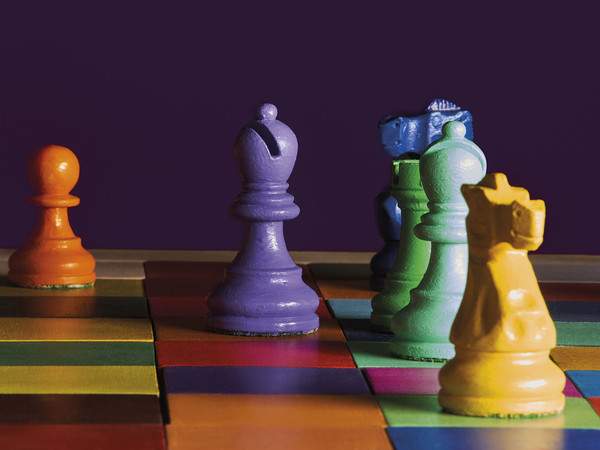Milan, Massimo Kaufmann's chess pieces are on display at the Museo del Novecento
On view at the Museo del Novecento in Milan is Massimo Kaufmann’s The Rules of the Game, an exhibition with a strong interactive and performative character that animates FORUM900. On display, until August 31, are four works, real artist’s chessboards: three of them, made of wood and with regulation dimensions (57x57 cm), consist of the usual 64 squares and 32 chess pieces painted with oil paints in 96 different colors; the fourth, Pan, smaller in size, is intended for children.
Despite the clear subversion of the first rule of chess-which here no longer involves solely black and white opposing each other but rather an infinite possibility of colors-the modalities and rules of the game remain identical and the chessboards perfectly usable: two fairly experienced players can confront each other according to all the canonical rules without incurring any drawback other than the perceptual confusion generated by the colors and accentuated by the continuous shifting of the pieces.
To demonstrate this, the four chessboards are made available to visitors who, with prior reservation, will be able to compete in exciting chess duels on Tuesdays during the lunch break and on Thursdays before scheduled talks. The artist will also be available for the challenges-a presence that transforms the exhibition project into a performance.
Massimo Kaufmann’s chess sets are conceived in a critical historical moment, 2020, which will not end with the waning of the pandemic but will continue in the Russian-Ukrainian conflict. It is therefore precisely in the theme of conflict that Kaufmann’s works are rooted: the “war,” which the game of chess represents and reproduces, is shown in a different aspect. Each piece on the chessboard maintains its functional characteristics but has an identity, given by its color, that prevents it from belonging to a precise side. A situation that generates cognitive confusion and encourages changes of camp and membership.
The game of chess thus becomes a metaphor for a conflict in which not only two antagonists confront each other but an innumerable composite of different subjectivities come alive in the game, as if to show a multilaterality of the components involved. As in real wars, there are factors that multiply the points of view and interests at play.
The game becomes more complicated, as much as the theme of the conflict becomes clearer, in the third chessboard. Made in 96 shades of gray, it is openly inspired by Picasso ’s Guernica by adopting the same title because contrary to popular belief Guernica is not black and white, but painted in an infinite variety of grays, the result of adding black to reds, blues, and yellows, in a range of “burned” colors, as war incinerates everything it touches.
It is perhaps this work, in its tribute to what is considered by many to be the most important work of the twentieth century, that constitutes the trai d’union" between the two major thematic cores of the exhibition: conflict, precisely, and painting. For Massimo Kaufmann, the main game remains painting, its very definition, with its infinite variables and possibilities of shaping meaning, be it enigmatic or polyvalent, without ignoring that any game still has its rules.
In the other two chessboards, the more brightly colored ones, The Rules of the Game and Caliban, painting also emerges as the protagonist. The artist mentions how colors in painting have always fought each other. In the most extraordinary works dedicated to war, such as those by Paolo Uccello or Boccioni, the clash takes shape through a chromatic dispute that seems to prepare for an explosion of energy. The idea that colors represent dynamic energy, like trumpet blasts and drum rolls, shows all the will to power that has always accompanied the rhetoric of war.
A program of challenges and meetings is also planned for June, in the presence of Massimo Kaufmann himself and the three authors of the texts in the catalog - Marco Senaldi, philosopher, curator and contemporary art theorist; Francesco Cataluccio, writer and essayist; and Lorenzo Madaro, art critic and curator - who will converse about chess, literature and contemporary art.
The exhibition, produced with the support of Analysis, is accompanied by the catalog The Rules of the Game published by Pondus.
For all information, you can visit the official website of the Museo del Novecento.
 |
| Milan, Massimo Kaufmann's chess pieces are on display at the Museo del Novecento |
Warning: the translation into English of the original Italian article was created using automatic tools. We undertake to review all articles, but we do not guarantee the total absence of inaccuracies in the translation due to the program. You can find the original by clicking on the ITA button. If you find any mistake,please contact us.





























